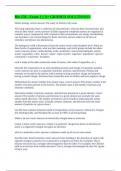Bio 150 - Exam 1 || A+ GRADED SOLUTIONS!!
Define biology correct answers The study of life/how life works
All living organisms share a collection of characteristics: what are these characteristics and
what do they mean? correct answers Exhibit organized complexity (atoms are organized in
complex ways), composed of cells, respond to their environment, use energy (metabolism),
can reproduce, can evolve(change for better survival), and are subject to the laws of
chemistry and physics (no phenomena).
The biological world is hierarchical from the atomic level to the biosphere level. What are
these levels of organization, what are their meanings, and which groups include the others
correct answers atoms> molecule(fatty acids, nucleiods)> macromolecule(lipids, nucleic
acids)> organelles> cells> tissues> organ> organ system> organism> population> species>
community> ecosystem> biosphere.
each is made of the other (molecules made of atoms, cells made of organelles, etc.)
Describe the composition of an atom including location and charge of subatomic particles.
correct answers an atom is composed of protons, neutrons, and electrons. Protons and
neutrons are located in the nucleus with a protons having a positive charge and neutrons
having a neutral charge. Electrons float around the atom in orbitals and have negative charge.
Differentiate the atomic number from atomic mass. correct answers The atomic number is the
number of protons present in the nucleus. The atomic mass is the number of protons and
neutrons combined.
Determine number of protons, neutrons, and electrons present for a given element. correct
answers The number of protons and electrons in a given element are normally the same
unless stated otherwise. The number of neutrons can be found by subtracting the atomic
number from the atomic mass. (Usually, protons, neutrons, and electrons have the same
amount of particles in a given atom.)
List the most common elements found in living things correct answers Carbon (C), Oxygen
(O), Hydrogen (H), and Nitrogen (N) account for 90% of all living things.
What is an ion correct answers an electrically charged atom or molecule
Cation v anion correct answers a cation is a positively charged ion (loses an electron) an
anion is a negatively charged ion (gains an electron).
what is a molecule correct answers a substance made up of two or more atoms.
describe ionic bond formation correct answers Ionic bonding is the attraction of atoms with
opposite charges (a positive ion is attracted to a negative ion NaCl for example). This is
because one atom has a stronger electronegativity than the other. For example, the Chlorine
pulls in an electron from sodium because Cl has a stronger electronegativity than Na. (game
of tug a war).
, Covalent bond formation correct answers A chemical bond formed by a shared pair of
electrons holding two different atoms together. They can be polar (charged with slight
charges on either end) or nonpolar (the almost equal sharing of electrons). This all depends
on the electronegativity of each atom.
Define electronegativity correct answers The ability of atoms to attract each other. If one
atom has a stronger electronegativity, it results in the unequal sharing of electrons. (tug of
war).
What is a nonpolar covalent bond? correct answers Electrons are shared equally, the
combined atoms have near the same electronegativity. These bonds do not mix will with
water. Most common in this class are C-H, C-C, O=O.
What is a polar covalent bond correct answers Electrons are shared unequally, the combined
atoms have different electronegativities which cause an electron to be pulled closer to the
higher electronegative atom. These bonds are charged and easily dissolve in water. Do not
pass through the phospholipid bilayer.
Describe hydrogen bonds and explain why they form correct answers a hydrogen bond is a
bond between a hydrogen atom and an electronegative atom in another molecule. They are
much weaker than covalent bonds but the presence of many weak hydrogen bonds can help
stabilize biological molecules, as in the case of nucleic acids and proteins. (most commonly
found in water since it avoids like charges and the slightly positive H is attracted to slightly
negative O).
Different types of chemical bonds. correct answers ionic bond - NaCl (most things bonded
with lithium or sodium)
polar covalent bond - WATER, NH, OH
nonpolar covalent bond - O2, C2, CH
hydrogen bond - between the hydrogen and oxygen of water.
(the bond within H2O is covalent, the bond between H2O is hydrogen)
Describe the composition and polar nature of a water molecule. correct answers A water
molecule consists of two hydrogen atoms contently bonded to one oxygen atom. Because
oxygen has as higher electronegativity, the electrons surrounding the hydrogen atoms will be
pulled closer to the oxygen atom, but not completely transferred. Since there is an unequal
sharing of electrons, water is polar and gives hydrogen a slightly positive charge and oxygen
a slightly negative charge.
Adhesion vs. Cohesion correct answers ADD-hesion: water molecules are attracted to other
polar molecules
CO-hesion: water molecules are attracted to other water molecules
Why does ice float on water? Why is this biologically important? correct answers When
water freezes, most water molecules become hydrogen bonded to four other water molecules,
forming an open crystalline structure we call ice. As the temperature increases and the ice
melts, some of the hydrogen bonds are destabilized and break, allowing the water molecules
to pack more closely together. This property allows underwater organisms to survive winters.
The water freezes from the top down, and does not freeze completely.




